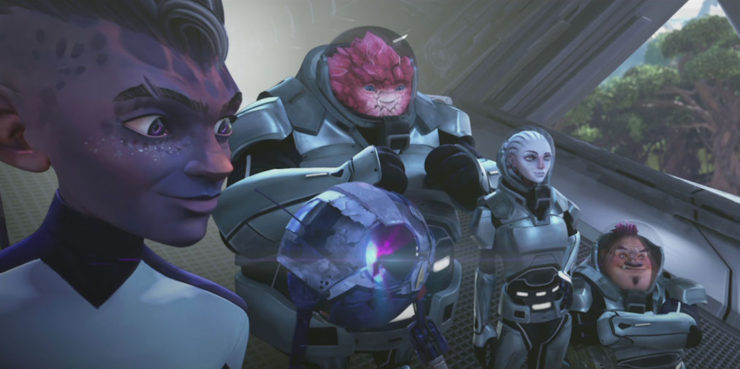Last week Paramount+ announced that it was canceling its animated Star Trek show, Star Trek: Prodigy. The decision shocked fans. The show had been renewed for a second season since its debut in 2021, and is currently in post-production. Also, Paramount+ didn’t just cancel Prodigy; it announced the show would be removed from the Paramount+ platform. It’s gone already, making it the only Star Trek show that has ever been made that is not currently available on the streaming platform.
Stepping back, the streaming business is in a crazy way right now. Many of the streamers have turned to this tactic of removing material so as to avoid paying licensing fees for those shows. The fact that Paramount+ has joined their ranks is sad, but no surprise. (The streamer also announced that it is removing three other recent series.)
But Star Trek: Prodigy isn’t just any show.
It is Star Trek’s first show aimed specifically at children. And while the one phrase logline that got tossed around when the show began—kids steal a starship—seems like your standard childhood tale of wish fulfillment, in reality the show that creators Kevin and Dan Hageman set out to make was anything but a typical kids’ show. Star Trek: Prodigy told the story of a group of children who have been enslaved to a ruthless tyrant and are trapped working on a mining colony. They stumble onto the abandoned Federation starship the USS Protostar during a rock collapse, and use it to make their escape.
While the season-long story that ensues certainly involves lots of fun adventures that play on classic Star Trek ideas—we get a Kobayashi Maru test; a time paradox; a Borg encounter; a trapped in the holodeck episode—the overarching story is actually quite poignant. Upon learning of the Federation from the ship’s onboard hologram, the children are so inspired by its ideals they decide they want to join. Later, when they discover their ship has been boobytrapped to destroy the entire Federation by the being who had enslaved them, they sacrifice pretty much everything, including the dreams of joining the Federation that have sustained them for so long, in order to try and save it from disaster.
It’s a story, in other words, that offers children some really powerful ideas about friendship, courage and self-sacrifice. It’s a story about finding yourself and your people in the act of giving yourself away.
Also, and to my mind incredibly boldly, the Hagemans quietly ground their show in some very challenging social realities. According to Walk Free, an international human rights organization focused on the eradication of slavery, almost 50 million people around the world are currently enslaved. Twelve million of them are children who are forced to work, to marry, to serve as sex workers, drug mules or soldiers. Their lives are filled with trauma.
Prodigy absolutely takes these experiences on board. The cast includes a teenager whose father brainwashed her into becoming his soldier; a young girl who was sold off after she refused to keep playing the monster in staged battles; a being who was hunted and captured like an animal; an orphan boy who discovers that his adopted mother actually sold him to buy a robot. And yet time and again these children rise above the pain, loss and fear they have to help both one another and total strangers.
In his initial 2021 review of Prodigy on Tor.com, Keith R.A. DeCandido particularly highlighted Rok-Tahk, the enormous eight-year-old rock-like girl who had been sold off for refusing to play a monster as his favorite character. Over the course of the season she became one of my favorites, too. As performed by the then-ten-year-old Rylee Alazraqui, Rok’s innocence gives her a precious vulnerability. You want good things for all of these characters; each one is a wonderful mixture of fragile and strong, broken and mighty. But those tensions play out most compellingly in the sweet and often delightful hero’s journey of Rok.
For long-time Star Trek fans, Star Trek: Prodigy also unexpectedly offered a new story for one of the Star Trek universe’s most iconic characters, Admiral Kathryn Janeway. One of the things that Trek has done very well over many years is to build each next show around not only a diverse and interesting team, but a radically new central character. Jean-Luc Picard was erudite and reserved in his approach to problem solving, where Kirk approached new situations with a greater creativity and dynamism. Deep Space Nine’s Commander Benjamin Sisko was more vulnerable than Picard, more playful, more relatable. Also he was a single dad with a son.
And Star Trek: Voyager’s Kathryn Janeway was likewise something new, nurturing but also steely in her resolve and endlessly hopeful of her crew’s potential and the possibility of getting home. When Star Trek: Picard launched a few years ago and people saw the kinds of stories that were possible now, the deep dive examinations of character being allowed, almost immediately it was Janeway that people began asking for. Where the longform storytelling of Deep Space Nine had naturally lent itself to deep character studies of Sisko and his crew, Voyager didn’t really function that way, or at least not for Janeway. She was in many ways the constant while characters like Seven of Nine were allowed to develop and grow. Also, there was just so much to actress Kate Mulgrew’s performance, so many layers to explore.
Prodigy has given Mulgrew new colors to paint with; on the show she plays not just the serious, responsible, nurturing Janeway that we know, but a hologram version of herself who acts more as a wisdom figure to the children (and often a playful one). It’s an absolutely delightful performance (and one that Mulgrew herself has said that she loves doing). In fact fans have been enjoying her work so much, many thought Janeway would return as a live-action character for the Picard series finale.
Buy the Book


System Collapse
The series is also clearly a quiet sequel to Voyager. The ship the children find is not just any Starfleet vessel, but an experimental prototype that none other than Janeway’s first officer Chakotay was commanding (and which actually looks a lot like Voyager). When we finally meet the real Janeway, she is searching for her friend, and over the course of the season the children discover little bits of information here and there that together eventually explain what has happened to him and where he and his crew are. At the end of the first season, most of the kids have committed to going with Janeway to finally find him. That story, which will involve travel both into the future and through other dimensions, seems like both a classic Star Trek challenge, and a wonderful one to experience through the eyes of children.
I could go on. I would dare anyone to show me a cooler live-action battle sequence than the one that occurs in the climax of the first season. The 3D computer-rendered artwork on Star Trek: Prodigy is truly next level, and the scoring, too.
The point is, Star Trek: Prodigy is not “just” a cute kids’ show. It’s a meaty addition to the Star Trek universe, and a story that has something important and special to offer to young people today. In an age where there seems to be so much fatalism about the future, Prodigy instead positions children as heroes in their own right and proposes they are capable of making a massive difference in the world, just by being generous and true to their own instincts.
The fate of Prodigy is not yet sealed. Paramount is allowing the Hageman Brothers to finish production on the second season, with the idea that CBS will then shop the series around to other networks. It makes little sense; the first major selling point of Paramount+ was that it was going to be the one stop shop for all of Star Trek. And when you start to break up a property like this, you’re just asking for trouble down the line. See: The Fox and Sony Marvel Cinematic Universes before Kevin Feige got there, and also since. (Seriously, what is the deal with all of these Spider-Man villain movies?)
But still, Prodigy is a Star Trek show. To me, it is the younger sibling to the live-action shows, not only in its earnestness and youth, but in its kind-hearted distillation of what Star Trek is at its best—emotionally resonant, insistently hopeful and inspiring. It is Star Trek through fresh eyes. We live in hope that this talented team of writers, artists and actors will have the chance to show us more of what they see.
Jim McDermott is a freelance magazine and screen writer living in New York, and the author of the upcoming Game of Thrones: A to Z Guide & Trivia Deck (which was ridiculously fun to write). Find him on Twitter, .Blue Sky or Substack.










